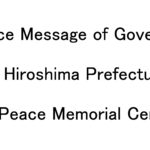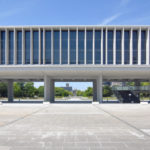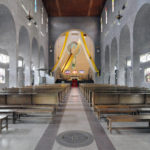Peace Memorial Park Q&A

Many people worldwide come to the Hiroshima Peace Memorial Park to commemorate the victims of the atomic bombing.
Some gaze at its beautifully maintained facilities and believe it was already a park at the time of the tragedy. Let’s review what kind of place the Peace Memorial Park is and what kind of history it holds, together with past articles.
Q: What kind of place is Peace Memorial Park?
A: It is a city park established in memory of the atomic bomb victims and to pray for everlasting world peace.
The Peace Memorial Park lies at the center of Hiroshima City, at the top of the delta between the old Ota River (Honkawa) and the Motoyasu River.
The area used to be a bustling shopping district where countless people met and mingled. However, on August 6, 1945, it was instantly annihilated by a single atomic bomb.
After the tragedy, the Peace Memorial Park and its facilities were built around the hypocenter as a symbol of everlasting peace, reaching completion in 1955.
The park is currently home to the Atomic Bomb Dome, a registered World Heritage Site, and the Hiroshima Peace Memorial Museum, a window into what Hiroshima was like at the time of the atomic bombing. It is also the location of the Hiroshima Victims Memorial Cenotaph, the National Peace Memorial Hall, the Hiroshima International Conference Center, and many other cenotaphs, monuments, and A-bomb phoenix trees. Many people continue to visit the park to offer their prayers.
It is also the site of the Hiroshima Peace Memorial Ceremony (Memorial Ceremony for the Atomic Bomb Victims and Peace Memorial Ceremony), held annually every August 6.
Q: What was the area around the Peace Memorial Park like before the bombing?
A: It was once the Nakajima District, the largest shopping district in Hiroshima, filled with many people.
The area we know now as the Peace Memorial Park was instantaneously reduced to ashes by the atomic bomb, leaving only a few buildings, including the crumbling Atomic Bomb Dome and a rest house. However, only just moments before, it was called the Nakajima District, the busiest shopping center of Hiroshima, home to many people, and a place of mingling and exchange. It was a bustling district lined with shops, inns, houses, temples, theaters, and restaurants.
Its bustle waned when the war intensified, as the residents were evacuated and supplies were lacking. Even so, Nakajima was still home to many. The film “In this Corner of the World” accurately portrays the district.
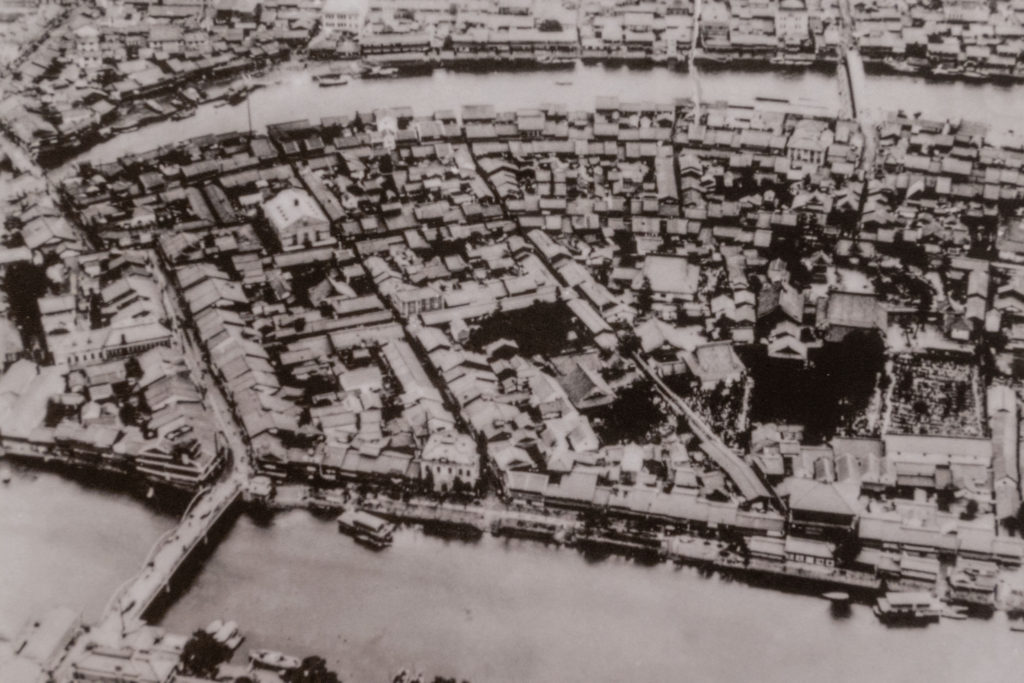
Nakajima District before the atomic bombing (courtesy of Noguchi Iwao, in the collection of Hiroshima Peace Memorial Museum)
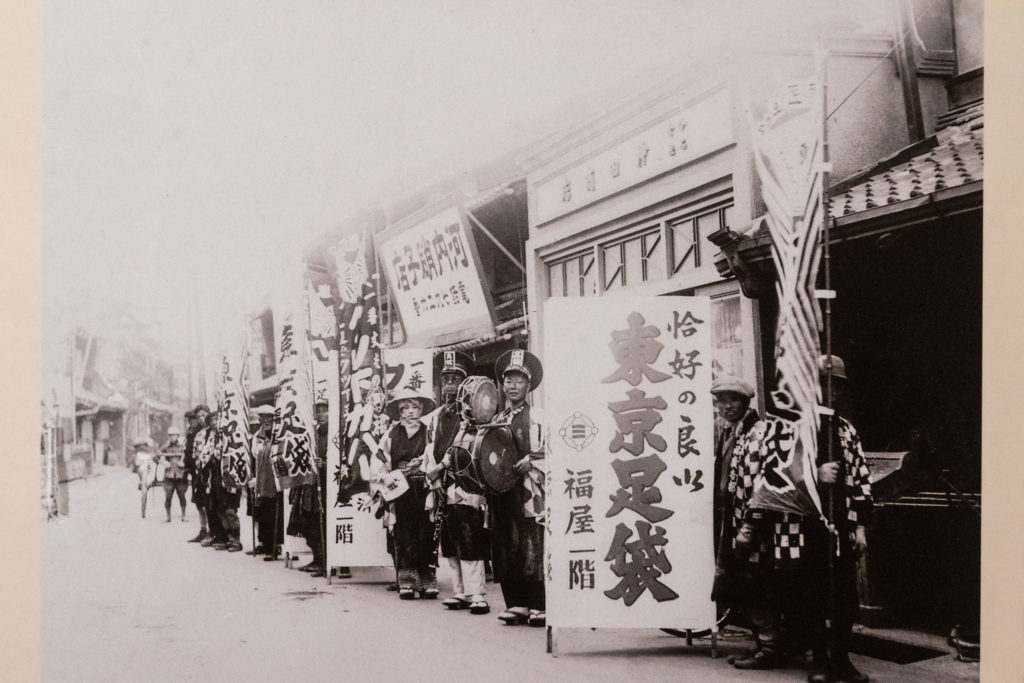
Tenjinmachi-suji Street in Nakajima District before the atomic bombing (courtesy of Mita Shigeru, in the collection of Hiroshima Peace Memorial Museum)
Related Articles:
“In This Corner of the World” Location Tour
https://hiroshimaforpeace.com/in-the-corner-of-this-world-location-tour/
The Lives of the People and Town After the Bombing; “Exhibit Facility for Atomic-Bombed Remnants”
Q: What kind of building was the Atomic Bomb Dome?
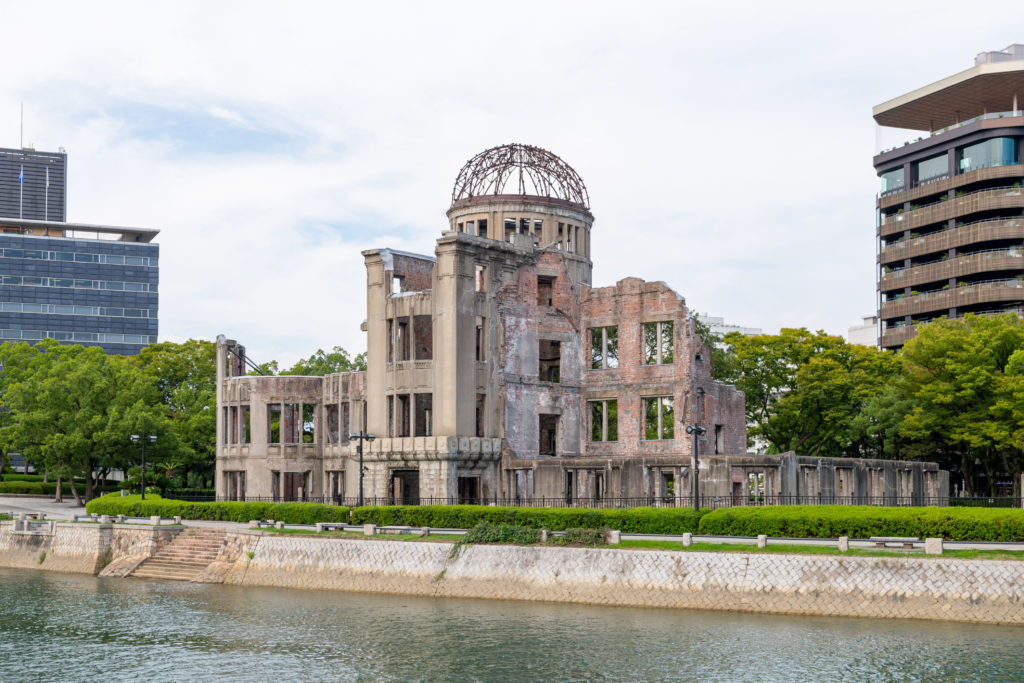
A: It was a Western-style building constructed in the early Taisho period and a venue for various events.
At the north side of the park lies the Atomic Bomb Dome, the most famous structure in Hiroshima. Constructed in the early Taisho period, it was a three-story Western-style brick building with a copper-sheeted elliptical dome. Before the atomic bombing, the building was known as the Hiroshima Prefectural Industrial Promotion Hall, a venue for art exhibitions and expositions for products from Hiroshima Prefecture. However, it ceased being an event venue around the end of World War II and was used as an office for the government and other administrative agencies.
On that day, the atomic bomb exploded at 160-meter point-blank range from the Industrial Promotion Hall Sangyo Shoreikan. The blast and heat rays wrecked the Sangyo Shoreikan, setting fire to its ceiling, and burning the building to the ground, instantly killing everyone inside.
After the war, the dome’s exposed steel frame came to be known as the Atomic Bomb Dome by the citizens of Hiroshima City. Today, the dome still looks almost exactly as it did during the tragedy, serving as a reminder of the devastation wrought by nuclear weapons.
In 1996, it was registered as a World Cultural Heritage site.
Related Articles:
History of the Atomic Bomb Dome
https://hiroshimaforpeace.com/atomic-bomb-dome/
Building, Column 3 “Atomic Bomb Dome (Originally the Hiroshima Prefectural Industrial Promotion Hall)”
https://hiroshimaforpeace.com/building-column-3-atomic-bomb-dome-originally-the-hiroshima-prefectural-industrial-promotion-hall/
Q: Who designed the Peace Memorial Park?

A: The park was designed by the master architect Tange Kenzo.
Tange Kenzo (丹下健三), one of Japan’s world-class architects who designed the Tokyo Metropolitan Government Building and other great buildings around the country. Tange was born in Osaka in 1913 but spent his student days in Hiroshima during the prewar period and had ties to the city. He positioned the Atomic Bomb Dome, the Hiroshima Victims Memorial Cenotaph, and the Peace Memorial Museum in a straight line as a prayer for peace and the repose of the victims’ souls.
The parapet of the Peace Bridge, which spans the southeast side of Peace Memorial Park, was designed by Noguchi Isamu, a world-renowned half-Japanese half-American sculptor. Tange asked Noguchi to design the parapet, and Noguchi’s enthusiasm led him to create a design that bridges Japan and the United States.
Related Articles:
Architecture Column ①: Hiroshima Peace Memorial Museum
https://hiroshimaforpeace.com/architecture-column-1-hiroshima-peace-memorial-museum/
Q: Are there any A-bombed trees left in the park?

A. The trees exposed to the atomic bomb were transplanted into the park, giving people courage as they continue living strong.
After the atomic bombing, the devastation and radiation were so horrific that many said Hiroshima would not see grass or trees for the next 75 years. Despite this, some trees in Hiroshima City survived the catastrophe and continue to live strong.
Unfortunately, no trees survived in Nakajima-cho, where the Peace Memorial Park is right now, since it was too close to the hypocenter. However, two species of A-bombed trees were transplanted in Peace Memorial Park, north of the East Wing of the Peace Memorial Museum. These are two phoenix trees that were exposed at 1,300 meters from the hypocenter and an Indian spider lily exposed at 2,200 meters. Their inspiring figures with verdant branches and leaves continue to inspire people to live strongly, even amid turbulent times.
Sharing the story of A-bombed trees with as many people as possible
https://hiroshimaforpeace.com/sharing-the-story-of-a-bombed-trees-with-as-many-people-as-possible/
Meeting Trees Sending Trees that Survived Atomic Bombing from Hiroshima to the World
https://hiroshimaforpeace.com/sending-trees-that-survived-atomic-bombing-from-hiroshima-to-the-world/
Peace Memorial Park
Address: 1 Nakajimacho 1 and 1-10 Otemachi, Naka-ku, Hiroshima City
Admission Fee: Free
Holidays: None
Hours: 24/7
Tags associated with this article



